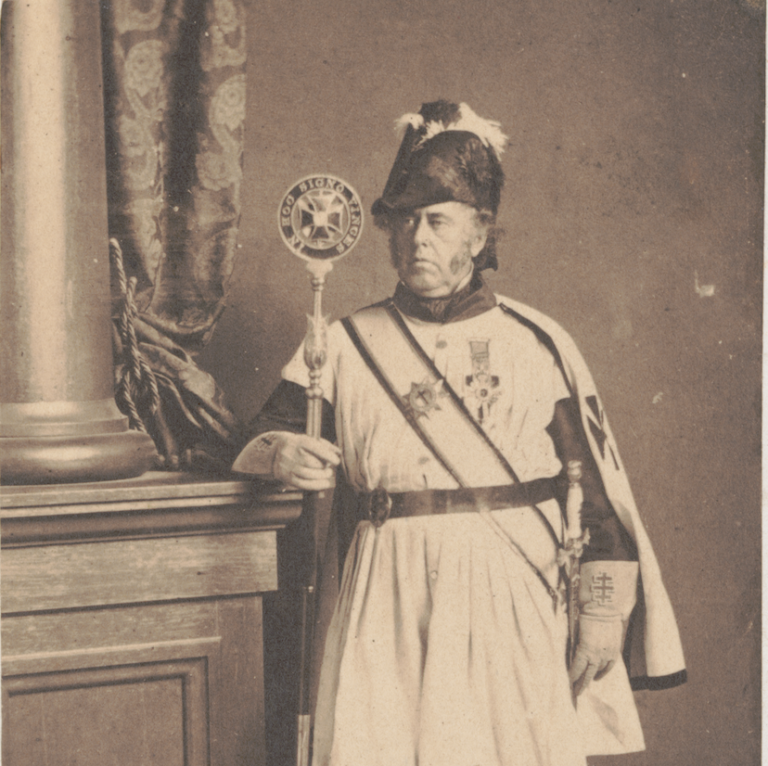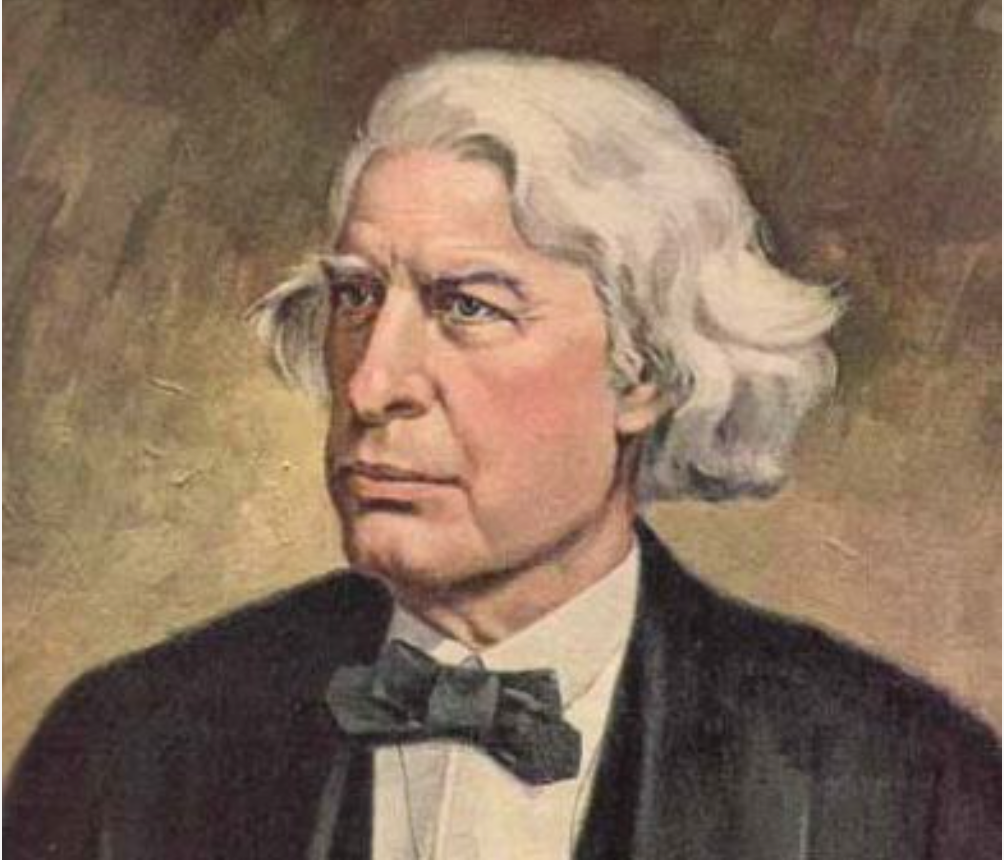Resurrection and Expansion
Local chapters formed their first Grand Chapter in Washington but activities soon waned in part due a national wave of anti-Masonic sentiment prompted by the Morgan Affair. The surviving chapters agreed to consolidate with Maryland in 1842 and formed the Grand Chapter of Maryland and the District of Columbia, which operated for the next twenty-five years. By the late 1860s, however, the District experienced a significant membership influx and renewed interest amongst the D.C. chapters to separate from Maryland and once again form their own Grand Chapter. They successfully dissolved the former body in 1867 and scheduled the inaugural officer installation ceremony for the new Grand Chapter of the District of Columbia on March 26.

Prominent organizers for the new Grand Chapter included Past Grand Master Benjamin B. French, a former Grand High Priest and General Grand Secretary of the General Grand Chapter, and Dr. Albert Mackey, a Past Grand High Priest of the General Grand Chapter and prominent national Masonic author. To commemorate the occasion, organizers opened the officer installation ceremony to the public – a symbolic gesture that may have served as a recruitment tool for prospective candidates. Organizers arranged for the ceremony to take place at the popular theater and venue known as Wall’s Opera House. French extended an invitation to President Andrew Johnson, a fellow Royal Arch Mason from Tennessee, who agreed to attend the ceremonies.
Installation festivities began around 4 o’clock on March 26 with a large procession from the Masonic Temple on 9th and F streets to the opera house. Participants, including grand lodge and craft lodge masons, Knights Templar, and representatives from each Royal Arch chapter in the District, gathered at the temple, formed a procession, and departed for the White House – their first stop. They entered the mansion’s grounds through the east gate and marched past one of the White House porticos where Johnson stood waiting to greet the procession. Johnson boarded a special executive carriage along with French, Mackey, and John Holmead – the inaugural Grand High Priest. They exited through the mansion’s west gate and proceeded down to the opera house.
Masons and guests took their seats in the packed theater while the Grand Chapter’s officers and visiting guests found their seats on the stage. “A seven-branch candlestick occupied the center of the front of the stage, and the national colors and banners of the Order were arrayed on either side. The hall and boxes were crowded, and a large number of ladies were present to witness the interesting ceremonies. A fine, large Chickering piano and a melodion, kindly loaned for the occasion by Mr. J. F. Ellis, were in position in front of the stage, and professor J.E. Schell presided.” (National Republican, May 24, 1867.)
French welcomed the crowd and then introduced Dr. Mackey who delivered a long and broad address filled with Royal Arch history and symbolism:
We have assembled this evening for the performance of a ceremony particularly Masonic – which, to Masons themselves, is unusual – To all others must appear strange and inexplicable. But it is the great particularity of the Masonic institution that it is founded on ceremonies – ceremonies which, in other societies, are but incidental, but in the Masonic are vital. Elsewhere they are but the clothing which ornaments the body – with us they are the body itself. And this arises from the very nature of Freemasonry, of which the best definition that has ever been given is that it is a science of morality veiled in allegory and illustrated by symbols. It is a science of morality – a science whose object is to teach great moral and religious truths, and these lessons of truth are inculcated and developed by the ancient method of symbolism. It is this symbolic character of the institution which causes it to differ from every other association which the wisdom or ingenuity of man has devised, and gives it to that attractive form which has always secured the unwavering attachment of its disciplines and its own on alterable perpetuity. […]
In fact, man’s earliest instruction is by symbols. The objective character of a symbol as best calculated to be grasped by the infant mind, whether the infancy of the mind be considered nationally or individually. In the first ages of the world all propositions were expressed in symbols. The first religions were eminently symbolic, because when language was yet in its infancy visible symbols were the most lively means of acting upon the mind and senses of the multitude. And we must bear this fact of the primary existence and predominance of symbolism in the earliest times constantly is mind when we are investigating the nature of the ancient religions with which the history of Freemasonry is so intimately connected. The older the religion the more the symbolism abounds. Modern religions may convene their dogmas in abstract prepositions; ancient religions always did so in symbols. […]


The science of symbolism, of which Freemasonry is at this day the only perfect exponent, presents itself to us, then, not only as something venerable for antiquity, but as sanctioned by the highest authority; for we know that the most divine of all teachers instructed the multitudes to whom He gave the bread of life in parables, which, it must be remembered, are only spoken symbols. […]
And these brethren are all here to do honor and to give welcome to that other and distinct class of the fraternity, forgetful of any differences of opinion, unmindful of their diversity of labor, remembering only that although their altars are different, and their theories in many respects opposed, yet they are all of one heart and one accord in obedience to that great lesson of their common fraternity, that they shall learn to know him whom they recognize, whatever be the temple, or the altar, or the sacrifice, as the Great Master Building, from whom we have received all light, and who has taught us how to act, that mankind, when resting for a moment from their contests of power and for place, may look upon these fraternal gatherings of our Order and say with envy and surprise, “Behold, how these Masons love one another.”
Holmead was then introduced, installed as Grand High Priest, and addressed the audience. He thanked those in attendance and elaborated on the events that culminated in the new Grand Chapter’s formation. The public ceremony concluded later that evening around 11 P.M. (It is unclear if Johnson remained for the entire ceremony.)
Thus, the Grand Chapter became the first of the current D.C. York Rite governing bodies. In 1897, the District’s five Knight Templar commanderies gathered to establish the Grand Commandery. More than two decades later, D.C. cryptic councils gathered in 1919 to establish the Grand Council of Royal and Select Masters – now referred to as the Grand Council of Cryptic Masons.
Between 1896 and 1907, the Grand Chapter occupied the “Royal Arch room” in the Masonic Temple on 9th and F streets, northwest. In 1907/1908, the temple’s tenants moved to the new temple on 13th Street and New York Avenue and the Grand Chapter occupied several rooms along with an office for the Grand High Priest and Grand Secretary. The body worked closely with their Masonic counterparts and participated in all major Masonic events in Washington.


Royal Arch Freemasonry attracted many prospective masons including Ohio Congressman and future President, James A. Garfield. Garfield petitioned Columbia Chapter 1 during his term in Congress. He received the Mark Master degree on April 4, 1866 and was exalted a Royal Arch Mason two weeks later on April 18, 1867. (Special dispensation was received to confer the degree) Companion Garfield’s election as President brought great excitement throughout the city’s Masonic community but their excitement soon turned to grief. Garfield died three months after his inauguration from illness sustained following his assassination attempt. Masonic organizations throughout the United States and abroad transmitted official resolutions of sympathy to the White House. One of the most poignant examples of Garfield’s appreciation for the craft appears in Grand Chapter’s proceedings for 1881. “I have had the pleasure of meeting him in the Chapter,” wrote Grand High Priest J. J. Jochum, “and can vouch, from a personal knowledge gained from conversation with him on the subject, that he was an enthusiastic in his admiration for and loyalty to the tenets of our Institution. It may not be known to you all, but it is a fact worthy of notice, that while lying on his death bed he gave instructions for the payment of his dues to the several Masonic organizations of which he was a member.” The President made sure he settled his accounts with his brethren even on his death bed.
